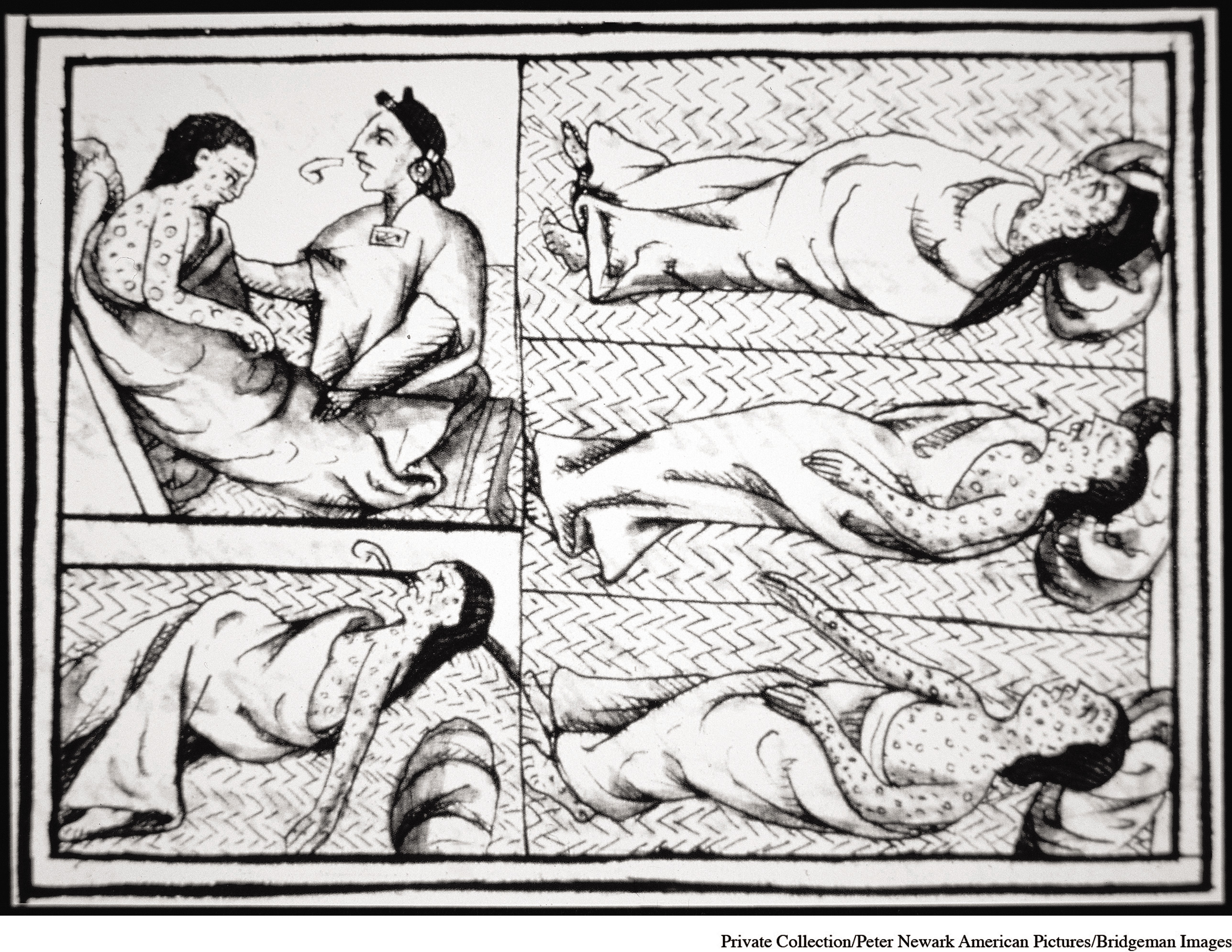The Columbian Exchange

Disease and Death among the Aztecs Smallpox, which accompanied the Spanish to the Americas, devastated native populations. This image, drawn by an Aztec artist and contained in the sixteenth-century Florentine Codex, illustrates the impact of the disease in Mesoamerica. (Private Collection/Peter Newark American Pictures/Bridgeman Images)
In sharply diminishing the population of the Americas, the Great Dying and the impact of the Little Ice Age created an acute labor shortage and certainly did make room for immigrant newcomers, both colonizing Europeans and enslaved Africans. Over the several centuries of the colonial era and beyond, various combinations of indigenous, European, and African peoples created entirely new societies in the Americas, largely replacing the many and varied cultures that had flourished before 1492. To those colonial societies, Europeans and Africans brought not only their germs and their people but also their plants and animals. Wheat, rice, sugarcane, grapes, and many garden vegetables and fruits, as well as numerous weeds, took hold in the Americas, where they transformed the landscape and made possible a recognizably European diet and way of life. Even more revolutionary were their animals—horses, pigs, cattle, goats, sheep—all of which were new to the Americas and multiplied spectacularly in an environment largely free of natural predators. These domesticated animals made possible the ranching economies and cowboy cultures of both North and South America. Horses also transformed many Native American societies, particularly in the North American West as settled farming peoples such as the Pawnee abandoned their fields to hunt bison from horseback. In the process, women lost much of their earlier role as food producers as a male-dominated hunting and warrior culture emerged. Both environmentally and socially, these changes were nothing less than revolutionary.
What large-scale transformations did European empires generate?
In the other direction, American food crops such as corn, potatoes, and cassava spread widely in the Eastern Hemisphere, where they provided the nutritional foundation for the immense population growth that became everywhere a hallmark of the modern era. In Europe, calories derived from corn and potatoes helped push human numbers from some 60 million in 1400 to 390 million in 1900. Those Amerindian crops later provided cheap and reasonably nutritious food for millions of industrial workers. Potatoes, especially, allowed Ireland’s population to grow enormously and then condemned many of the Irish to starvation or emigration when an airborne fungus, also from the Americas, destroyed the crop in the mid-nineteenth century. In China, corn, peanuts, and especially sweet potatoes supplemented the traditional rice and wheat to sustain China’s modern population explosion. By the early twentieth century, food plants of American origin represented about 20 percent of total Chinese food production. In Africa, corn took hold quickly and was used as a cheap food for the human cargoes of the transatlantic trade. Scholars have speculated that corn, together with peanuts and cassava, underwrote some of Africa’s population growth and partially offset the population drain of the slave trade.
Beyond food crops, American stimulants such as tobacco and chocolate were soon used around the world. By the seventeenth century, how-to manuals instructed Chinese users on smoking techniques, and tobacco had become, in the words of one enamored Chinese poet, “the gentleman’s companion, it warms my heart and leaves my mouth feeling like a divine furnace.”10 Tea from China and coffee from the Islamic world also spread globally, contributing to this worldwide biological exchange. Never before in human history had such a large-scale and consequential diffusion of plants and animals operated to remake the biological environment of the planet.
Furthermore, the societies that developed within the American colonies drove the processes of globalization and reshaped the world economy of the early modern era (see Chapter 14 for a more extended treatment). The silver mines of Mexico and Peru fueled both transatlantic and transpacific commerce, encouraged Spain’s unsuccessful effort to dominate Europe, and enabled Europeans to buy the Chinese tea, silk, and porcelain that they valued so highly. The plantation owners of the tropical lowland regions needed workers and found them by the millions in Africa. The Atlantic slave trade, which brought these workers to the colonies, and the sugar and cotton trade, which distributed the fruits of their labor abroad, created a lasting link among Africa, Europe, and the Americas, while scattering peoples of African origin throughout the Western Hemisphere.
This enormous network of communication, migration, trade, disease, and the transfer of plants and animals, all generated by European colonial empires in the Americas, has been dubbed the “Columbian exchange.” It gave rise to something wholly new in world history: an interacting Atlantic world connecting four continents. Millions of years ago, the Eastern and Western hemispheres had physically drifted apart, and, ecologically speaking, they had remained largely apart. Now these two “old worlds” were joined, increasingly creating a single biological regime, a “new world” of global dimensions.
The long-term benefits of this Atlantic network were very unequally distributed. Western Europeans were clearly the dominant players in the Atlantic world, and their societies reaped the greatest rewards. Mountains of new information flooded into Europe, shaking up conventional understandings of the world and contributing to a revolutionary new way of thinking known as the Scientific Revolution. The wealth of the colonies—precious metals, natural resources, new food crops, slave labor, financial profits, colonial markets—provided one of the foundations on which Europe’s Industrial Revolution was built. The colonies also provided an outlet for the rapidly growing population of European societies and represented an enormous extension of European civilization. In short, the colonial empires of the Americas greatly facilitated a changing global balance of power, which now thrust the previously marginal Western Europeans into an increasingly central and commanding role on the world stage. “Without a New World to deliver economic balance in the Old,” concluded a prominent world historian, “Europe would have remained inferior, as ever, in wealth and power, to the great civilizations of Asia.”11
